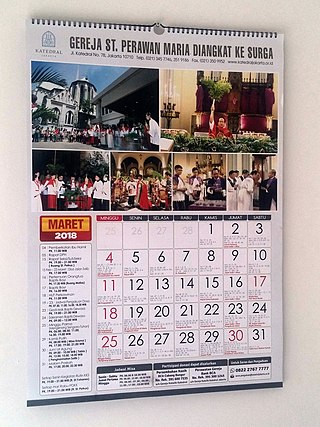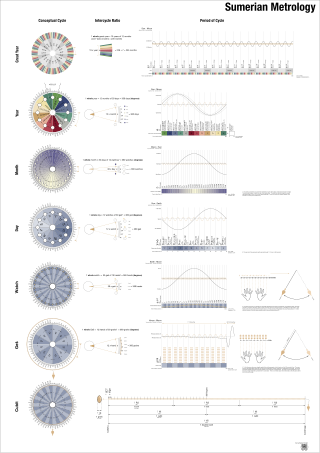Related Research Articles

A calendar is a system of organizing days. This is done by giving names to periods of time, typically days, weeks, months and years. A date is the designation of a single and specific day within such a system. A calendar is also a physical record of such a system. A calendar can also mean a list of planned events, such as a court calendar or a partly or fully chronological list of documents, such as a calendar of wills.

The full moon is the lunar phase when the Moon appears fully illuminated from Earth's perspective. This occurs when Earth is located between the Sun and the Moon. This means that the lunar hemisphere facing Earth—the near side—is completely sunlit and appears as an approximately circular disk. The full moon occurs roughly once a month.

The Hebrew calendar, also called the Jewish calendar, is a lunisolar calendar used today for Jewish religious observance, and as an official calendar of the state of Israel. It determines the dates for Jewish holidays and the appropriate public reading of Torah portions, yahrzeits, and daily Psalm readings, among many ceremonial uses. In Israel, it is used for religious purposes, provides a time frame for agriculture, and is an official calendar for civil holidays, alongside the Gregorian calendar.

The Hijri calendar, also known in English as the Muslim calendar and Islamic calendar, is a lunar calendar consisting of 12 lunar months in a year of 354 or 355 days. It is used to determine the proper days of Islamic holidays and rituals, such as the annual fasting and the annual season for the great pilgrimage. In almost all countries where the predominant religion is Islam, the civil calendar is the Gregorian calendar, with Syriac month-names used in the Levant and Mesopotamia but the religious calendar is the Hijri one.
Intercalation or embolism in timekeeping is the insertion of a leap day, week, or month into some calendar years to make the calendar follow the seasons or moon phases. Lunisolar calendars may require intercalations of both days and months.

A lunisolar calendar is a calendar in many cultures, combining lunar calendars and solar calendars. The date of Lunisolar calendars therefore indicates both the Moon phase and the time of the solar year, that is the position of the Sun in the Earth's sky. If the sidereal year is used instead of the solar year, then the calendar will predict the constellation near which the full moon may occur. As with all calendars which divide the year into months there is an additional requirement that the year have a whole number of months. In this case ordinary years consist of twelve months but every second or third year is an embolismic year, which adds a thirteenth intercalary, embolismic, or leap month.
A month is a unit of time, used with calendars, that is approximately as long as a natural orbital period of the Moon; the words month and Moon are cognates. The traditional concept arose with the cycle of Moon phases; such lunar months ("lunations") are synodic months and last approximately 29.53 days. From excavated tally sticks, researchers have deduced that people counted days in relation to the Moon's phases as early as the Paleolithic age. Synodic months, based on the Moon's orbital period with respect to the Earth–Sun line, are still the basis of many calendars today, and are used to divide the year.

The Metonic cycle or enneadecaeteris is a period of almost exactly 19 years after which the lunar phases recur at the same time of the year. The recurrence is not perfect, and by precise observation the Metonic cycle defined as 235 synodic months is just 2 hours, 4 minutes and 58 seconds longer than 19 tropical years. Meton of Athens, in the 5th century BC, judged the cycle to be a whole number of days, 6,940. Using these whole numbers facilitates the construction of a lunisolar calendar.
A moveable feast is an observance in a Christian liturgical calendar which occurs on different dates in different years.

Nisan in the Babylonian and Hebrew calendars is the month of the barley ripening and first month of spring. The name of the month is an Akkadian language borrowing, although ultimately originates in Sumerian nisag "first fruits". In the Hebrew calendar it is the first month of the ecclesiastical year, called the "first of the months of the year", "first month", and the month of Aviv בְּחֹ֖דֶשׁ הָאָבִֽיב ḥōḏeš hā-’āḇîḇ). It is called Nisan in the Book of Esther in the Tanakh and later in the Talmud, which calls it the "New Year", Rosh HaShana, for kings and pilgrimages. It is a month of 30 days. In the year 2023, 1 Nisan will occur on 23 March. Counting from 1 Tishrei, the civil new year, it would be the seventh month, but in contemporary Jewish culture, both months are viewed as the first and seventh simultaneously, and are referred to as one or the other depending on the specific religious aspects being discussed.
Aviv means "barley ripening", and by extension "spring season" in Hebrew. It is also used as a given name, surname, and place name, as in Tel Aviv. The first month of the year is called the month of Aviv in the Pentateuch. The month is called Nisan in the book of Esther, and in subsequent post-exilic history up to the present day. These names are sometimes used interchangeably, although Aviv refers to the three month season, and Nisan is called the "first month of Aviv."

Adar is the sixth month of the civil year and the twelfth month of the religious year on the Hebrew calendar, roughly corresponding to the month of March in the Gregorian calendar. It is a month of 29 days.
The history of calendars, that is, of people creating and using methods for keeping track of days and larger divisions of time, covers a practice with ancient roots.

Jeconiah, also known as Coniah and as Jehoiachin, was the nineteenth and penultimate king of Judah who was dethroned by the King of Babylon, Nebuchadnezzar II in the 6th century BCE and was taken into captivity. He was the son and successor of King Jehoiakim, and the grandson of King Josiah. Most of what is known about Jeconiah is found in the Hebrew Bible. Records of Jeconiah's existence have been found in Iraq, such as the Jehoiachin's Rations Tablets. These tablets were excavated near the Ishtar Gate in Babylon and have been dated to c. 592 BCE. Written in cuneiform, they mention Jeconiah and his five sons as recipients of food rations in Babylon.

The Babylonian calendar was a lunisolar calendar with years consisting of 12 lunar months, each beginning when a new crescent moon was first sighted low on the western horizon at sunset, plus an intercalary month inserted as needed by decree. The calendar is based on a Sumerian predecessor preserved in the Umma calendar of Shulgi.
Mercedonius, also known as Mercedinus, Interkalaris or Intercalaris, was the intercalary month of the Roman calendar. The resulting leap year was either 377 or 378 days long. It theoretically occurred every two years, but was sometimes avoided or employed by the Roman pontiffs for political reasons regardless of the state of the solar year. Mercedonius was eliminated by Julius Caesar when he introduced the Julian calendar in 45 BC.

Rosh HaShanah is the Jewish New Year. The biblical name for this holiday is Yom Teruah It is the first of the Jewish High Holy Days, as specified by Leviticus 23:23–25, that occur in the late summer/early autumn of the Northern Hemisphere. Rosh Hashanah begins a ten-day period of penitence culminating in Yom Kippur, as well as beginning the cycle of autumnal religious festivals running through Sukkot and ending in Shemini Atzeret.
Tishri-years, often called the Jewish Civil Calendar, is an ancient calendar system used in Israel/Judea, and the Jewish diaspora. It is based on, and is a variation of, the Nisan-years, which is often called the Jewish Religious Calendar. Tishri-years is similar to, and sometimes equivalent to, the Ancient Macedonian calendar used by the Hellenistic empires. They are all lunisolar years beginning from Autumn, but could differ by a month.
Yom tov sheni shel galuyot, also called in short yom tov sheni, means "the second festival day in the Diaspora", and is an important concept in halakha. The concept refers to the observance of an extra day of Jewish holidays outside of the Land of Israel.
Several calendars have been used in pre-Islamic Arabia. Inscriptions of the ancient South Arabian calendars reveal the use of a number of local calendars. At least some of these South Arabian calendars followed the lunisolar system. For Central Arabia, especially Mecca, there is a lack of epigraphic evidence, but details are found in the writings of Muslim authors of the Abbasid era. Some historians maintain that the pre-Islamic calendar used in Central Arabia was a purely lunar calendar similar to the modern Islamic calendar. Others concur that the pre-Islamic calendar was originally a lunar calendar, but suggest that about 200 years before the Hijra it was transformed into a lunisolar calendar, which had an intercalary month added from time to time to keep the pilgrimage within the season of the year when merchandise was most abundant.
References
- ↑ James B. Pritchard, ed. Ancient Near Eastern Texts Relating to the Old Testament (Princeton, NJ: Princeton University Press, 1969), 269-317.
- ↑ D. J. Wiseman, Chronicles of Chaldean Kings (625-556 B.C.) in the British Museum (London: The Trustees of the British Museum, 1961).
- ↑ Jack Finegan, Handbook of Biblical Chronology, rev ed. (Peabody MA: Hendrickson Publishers), 25-42.
- ↑ Colin, Alister Ronan, Measurement of Time and Types of Calendars, from 'Calendar', in Encyclopædia Britannica, vol 3 (Chicago: Encyclopædia Britannica, Inc, 1984), 596
- ↑ "Month" in Encyclopædia Britannica, vol VI (Chicago: Encyclopædia Britannica, Inc, 1986), 1024.
- ↑ "The Phoenician-Punic menology | Article RAMBI000217723 | The National Library of Israel". www.nli.org.il. Retrieved 2021-08-31.
- ↑ Richard A. Parker and Waldo H. Dubberstein, Babylonian Chronology, 626 B.C. - A.D. 75 (Providence, RI: Brown University Press, 1956)